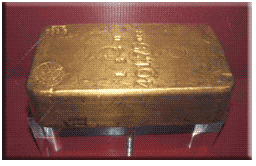The Gold Standard
Gold has been highly prized by humans from earliest times. The metal's scarcity, beauty, portability and ease of shaping are enticing attractions.
 A nation on the gold standard is one that uses gold as the standard of value for its currency. An individual would be able to take any type of legal tender to the proper authorities and redeem that form of money for gold at a specified rate.
Silver, not nearly as rare as gold, had been the standard for most of the world's currencies until the Industrial Revolution in the 19th century. The increase in world trade which accompanied industrial development led to demands for the adoption of the gold standard. The reasons were twofold:
A nation on the gold standard is one that uses gold as the standard of value for its currency. An individual would be able to take any type of legal tender to the proper authorities and redeem that form of money for gold at a specified rate.
Silver, not nearly as rare as gold, had been the standard for most of the world's currencies until the Industrial Revolution in the 19th century. The increase in world trade which accompanied industrial development led to demands for the adoption of the gold standard. The reasons were twofold:
- The gold standard would remove much risk of currency fluctuations from international trade; businessmen would be able to make decisions in full knowledge of what the exchange rates would be
- The gold standard would prevent governments from inducing inflation by the issuance of paper money that was not backed by gold
In short, the gold standard was a force for stability.
Britain, the first industrialized power, adopted the gold standard around 1820. The United States did not follow suit until 1873 (the Coinage Act of 1873, or known to its critics as the "Crime of '73"). France and Germany followed shortly thereafter.
The gold standard came under bitter attack in the United States, first by the
National Greenback Party in the 1870s and later by the Democrats under
William Jennings Bryan, particularly in the
Election of 1896.
The gold standard prevailed in most industrialized countries, although wavering a bit during World War I, until the
depression of the 1930s. Britain abandoned the standard in 1931 and the United States in 1933. Since the late 1970s no country in the world has been willing to redeem its currency in gold.
 A nation on the gold standard is one that uses gold as the standard of value for its currency. An individual would be able to take any type of legal tender to the proper authorities and redeem that form of money for gold at a specified rate.
Silver, not nearly as rare as gold, had been the standard for most of the world's currencies until the Industrial Revolution in the 19th century. The increase in world trade which accompanied industrial development led to demands for the adoption of the gold standard. The reasons were twofold:
A nation on the gold standard is one that uses gold as the standard of value for its currency. An individual would be able to take any type of legal tender to the proper authorities and redeem that form of money for gold at a specified rate.
Silver, not nearly as rare as gold, had been the standard for most of the world's currencies until the Industrial Revolution in the 19th century. The increase in world trade which accompanied industrial development led to demands for the adoption of the gold standard. The reasons were twofold: